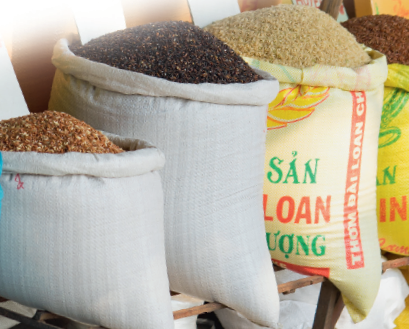
Siegwerk develops new packaging solution for extrusion lamination of woven sacks
Siegwerk has developed a new flexo ink system for woven sacks, which provides an alternative to proven gravure print technology and appeals in terms of both print quality and mechanical resilience as well as adhesion.
Woven sacks have long been a proven method of packaging rice, flour and other types of cereals and are used very frequently, particularly in Asia and Africa. Woven polypropylene-based (PP) bags are already in use as resilient carrier bags in supermarkets here in Europe. Essentially this type of packaging is based on a roughly 20μm thick Coex OPP film, which is usually coated either by extrusion or, more rarely, by adhesive lamination using a woven PP film. During extrusion, a melt deposit consisting of a PE/PP polymer mix provides the adhesion between the two films.
Basically, this structure is perfect for reverse printing. However, except in the case of a few toluene-based gravure-printing inks, extrusion has tended to reduce the effectiveness of flexo ink/polymer adhesion. In particular, weak bonding forces between film layers and therefore potential delamination (poor adhesion) represent a high risk. For this reason, woven PP sacks are mainly surface-printed during flexo printing processes, although this severely limits the packaging’s mechanical resilience and design options.
Advantages of the new ink system
In light of the above, Siegwerk has now developed a new ink system including colors, white and an extrusion-compatible lacquer to overcome the previous limitations of the woven PP sack printing process. The new toluene-free ink solution is based on NC 169-1, the typical nitrocellulose-based ink technology, which like white and lacquer complies fully with European food packaging regulations. The innovative ink system does not damage photopolymer plates and is ideal for HD flexo printing, as it also enables sophisticated designs to be printed. This user-friendly innovation offers printers clear benefits: no additives at the press, reusable return inks, unimpaired plates and good adhesion. The new colored ink system is also suitable for NC-based master-batch inks mixed using a dosing system. Finally, this new ink system opens up entirely new applications and branding opportunities, especially given the high quality of its print results and high adhesion values, which deliver outstanding packaging resilience.
Appealing benefits of the new solution:
- Packaging quality and appearance: significantly improved print quality and glossier laminated structures than prior applications.
- The specially developed XL1 lacquer ensures good adhesion between printing inks and PE/PP polymers. It remains stable over time and thus enables longer intervals between printing and extrusion without adversely affecting adhesion values.
- The extrusion process is now feasible both in-line and off-line.
- Outstanding resilience: protected by the film, the printed image/design is not damaged during transport.
- The newly developed White PA31 backs up the good adhesion values and provides high opacity.
About Siegwerk
Siegwerk, a sixth-generation family-owned company, is one of the leading international manufacturers of printing inks and individual solutions for packaging applications, labels, and catalogs. With more than 180 years of experience, the company has solid expertise in and knowledge of many printing procedures. A global manufacturing and service network ensures customers consistently high-quality products and services. In keeping with the company’s philosophy "Ink, Heart & Soul", Siegwerk seeks long-term cooperation with its business partners. Siegwerk employs some 5,000 people worldwide in more than 30 country organizations and is headquartered in Siegburg near Cologne. Further information on Siegwerk can be found at www.siegwerk.com
Source: Siegwerk






